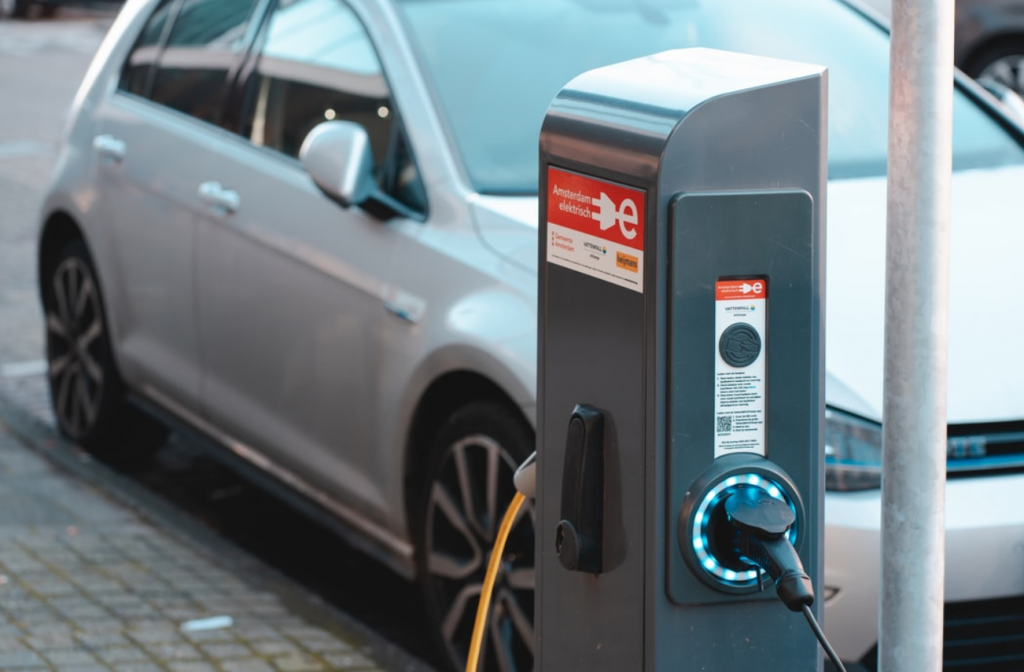Electric Vehicles
What is an Electric Vehicle?
An Electric Vehicle (EV) is a vehicle which is run either partially or fully powered by electric power.
How do EV’s work?
EV’s are very similar to an automatic car as they have a forward and reverse mode. When the vehicle is placed in gear the following happens:
- Power from the DC battery is converted into AC electricity by the inverter and is transferred to the electric motor
- When the accelerator pedal is pressed this sends a signal to the controller which will adjust the vehicles speed by changing the frequency of AC power being received from the inverter to the motor
- The motor connects and turns the wheels of the vehicle through a cog
- When the brakes are pressed or the car is decelerating, the motor becomes an alternator and produces power, which it sends back to the battery
What are the components of an electric vehicle?
EVs have an electric motor which converts electric energy into mechanical energy and is delivered to the wheels. Electric motors are a well-established, reliable, and durable technology. An inverter converts the DC (Direct Current) power to AC (Alternating Current) power used in an electric vehicle motor. The inverter can change the speed at which the motor rotates and increase or decrease the power of the motor. EVs have single speed (automatic) transmission. This means that the rate of change of speed is almost linear. This gives the driver almost instant access to power, with no loss. The controller is the brain of the vehicle – it manages all parameters. It also controls the rate of charge using information from the battery.
EVs use a battery to store the electrical energy which is used to power the vehicle. Once the battery has stored enough energy the vehicle is ready to use. When the car is driven it uses the stored energy therefore a battery charger is required to charge it up again. The charger converts AC power from the electricity network to DC power stored in a battery. A battery charger controls the voltage level of the battery cells, monitors the cell temperatures, and controls the charge to maintain good battery health. All EVs are supplied with a standard charging cable for charging at home or at standard public charging points. A fast charge point will have its own cable.
What types of electric vehicles are available?
There are different types of electric vehicles such as Battery Electric Vehicles (BEVs), Hybrid Electric Vehicles (HEVs) and Plug-in Hybrid Electric Vehicles (PHEVs) these are described in more detail below:
Battery Electric Vehicles (BEVs): A vehicle which uses a battery as the sole means of energy storage which drives the vehicle. A BEV does not have any fossil fuel engine or generator. It is driven solely by an electric motor with battery energy storage.
Hybrid Electric Vehicle (HEVs): A vehicle which uses a combination of electric power and petrol/diesel power to drive the vehicle. A HEV has an internal combustion engine and an electric motor. The electric battery is only charged by the internal combustion engine, the motion of the wheels or a combination of both this means there is no charging connector for HEVs.
Plug-in Hybrid Electric Vehicles (PHEV’s): A vehicle which uses a combination of electric power and petrol/diesel power to drive the vehicle. The battery can be recharged like HEVs through the internal combustion engine or wheel motion. However, PHEVs can be charged from a charge point giving the driver access to cheaper and cleaner electricity for the vehicle. There are other types of PHEV’s such as the Range Extended Electric Vehicle (REEV). A REEV has a small petrol-powered generator which is used to recharge the battery and extend the range of the vehicle when the battery level is low. This is a more efficient way of propelling the vehicle than using the same fuel in a traditional engine.
According to SEAI, there are over 35,000 BEV and PHEV’s on the roads in Ireland today.

SEAI’s Journey Cost Calculator has been used to compare a BEV, diesel and petrol vehicle based on an annual mileage of 18,000 km. Comparison Results | Electric Vehicles | SEAI
| Vehicle | Nissan Leaf | Peugeot 208 | Nissan Micra |
| Fuel | Battery Electric | Diesel | Petrol |
| Total Cost of Ownership | €39,115 | €44,170 | €42,145 |
| Current Retail Price | €38,447 | €25,790 | €19,395 |
| Annual Fuel / Energy Cost | €339 | €958 | €1,375 |
| Electric Range | 270 km | ||
| Tailpipe emissions | 0g CO2/km | 107g CO2/km | 125g CO2/km |
*The calculator is used for estimation purposes only and assumes the use of standard driving cycles. Actual energy and CO2 savings will vary depending on several factors such as driver behaviour, weather conditions and vehicle conditions. Total Cost of Ownership = Price + (Annual Energy Cost + Tax + Maintenance) x lifespan) – SEAI Grant – VRT reduction
The current retail price of a BEV is significantly higher than its diesel and petrol counterparts. However, the total costs of ownership of a BEV is significantly less due to reduced maintenance costs, lower energy costs, reduced motor tax and its also better for the environment!
A list of registered One Stop Shops in Ireland is expected to be published at the end of March 2022.
Can I get a grant towards my purchase of an EV?
Yes, SEAI offers an electric vehicle purchase grant up to a maximum of €5000 for qualifying BEV’s which are purchased privately. EV’s which have a list price of less than €14,000 are not eligible to receive a grant. The grant amounts for privately purchased vehicles will depend on the list price of the vehicle as can be seen in the table below.
| List Price of Approved EV | BEV |
| €14,000 – €15,000 | €2,000 |
| €15,000 – €16,000 | €2,500 |
| €16,000 – €17,000 | €3,000 |
| €17,000 – €18,000 | €3,500 |
| €18,000 – €19,000 | €4,000 |
| €19,000 – €20,000 | €4,500 |
| More than €20,000 | €5,000 |
*SEAI grants are not available for second hand EV’s
Plugin Hybrid Electric Vehicles (PHEV) are no longer offered grant support as of the 1st January 2022.
Compare Electric Car Running Costs | Electric Vehicles | SEAI
How do you charge an electric vehicle?
An electric vehicles battery is charged by connecting the vehicle to a charge point using a charging cable. There are several different types of charging points which can be used to charge BEV’s and PHEV’s which have been defined by SEAI and can be seen below.
Domestic charging: Electric vehicle drivers can charge their electric vehicle at their homes if they have a home charger installed. Cars are often charged overnight and use night-rate electricity at lower tariffs than if the vehicle was charged during the day.
On-site charging: For organisations which use EV’s, charging of the vehicles will happen on-site and overnight while the vehicle is parked. The biggest advantage of overnight charging is the opportunity to use night-rate electricity at lower tariffs.
On-street charging: It may be necessary to recharge to extend the range of the vehicle during the day. EV drivers can access the public on-street charging infrastructure for this on an ad-hoc basis.
Destination charging: Like on-street charging, destination charging can be accessed for top-ups to your vehicle where required. Many public car parks, shopping centres, hotels will have charging units.
Fast or rapid charging: Many service stations provide fast charging where it only takes 30-40 minutes to charge an EV vehicle to 80% charge. For fast charging you don’t use your own cable. The charge point has a cable that attaches to a different charging port on the vehicle than the one use in domestic, on-street and destination charging.
Can I get a grant towards the installation of a vehicle charge point at my home?
Yes, there is currently a government funded support scheme known as the Electric Vehicle Home Charger Grant which has been designed to assist homeowners’ transition to EV’s. It provides financial support to homeowners of up to €600 towards the purchase and installation of an electric vehicle home charger unit. In order to apply for this grant you must be the owner of an eligible new or second-hand electric vehicle from the 1st January 2018. To see other eligibility criteria, click here.
